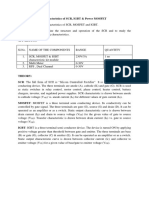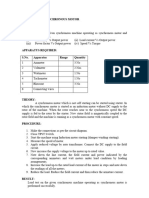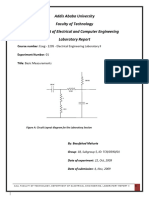Lab Report 4
Uploaded by
Yohannes AlemayehuLab Report 4
Uploaded by
Yohannes AlemayehuAddis
Ababa University
Faculty of Technology
Department of Electrical and Computer Engineering
Laboratory Report
Course number: Eceg: ‐ 2205 ‐ Electrical Engineering Laboratory II
Experiment Number: 04
Title: Regulated DC power Supply
Figure A: Waveform generated by a filtered rectified signal
By: Besufekad Mekuria
Group: 1B, Subgroup 5, ID: TCR/0590/01
Date of Lab. session: November 25, 2009
Date of submission: December 09, 2009
AAU, FACULTY OF TECHNOLOGY, DEPARTMENT OF ELECTRICAL ENGINEERING, LABORATORY REPORT 0
TABLE OF CONTENTS:
Section SubTitle Location
NO
1.1 Introduction Page Two
1.2 Objective Page Two
1.3 Preparation Page Two
1.4 Used Equipment Page Two
1.5 Components used Page Three
1.6 Theory Page Three
1.7 Procedure Page Four
1.8 Results Page Five
1.9 Conclusion Page Six
AAU, FACULTY OF TECHNOLOGY, DEPARTMENT OF ELECTRICAL ENGINEERING, LABORATORY REPORT 1
Regulated DC power Supply
1.1 INTRODUCTION
In most electrical power generation stations, power is usually generated in the
form of alternating current (AC) this is due to its relatively cheaper cost and its
importance in industrial machines. However when it comes to lower scale electrical
devices that are used in our homes like televisions, Computers, Radios, etc, they can
only operate on a constant Direct Current supply (DC) and since generating DC on a wide
commercial scale is very expensive, another method had to be devised to obtain the
required DC voltage from the supplied AC Voltage and integrate this mechanism into the
circuitry of this devices.
This important process usually involves the following sequential steps:
Input AC waveform ÆRectificationÆFilteringÆRegulationÆOutput DC
Therefore it is this process of converting AC to DC that we will mainly be
concerned about in this booklet.
1.2 OBJECTIVE
A. To introduce the concepts of Rectification, Filtering and Regulation.
B. To develop the skill of using diodes for clipping away the non‐required negative cycle (Half wave
Rectification).
C. Also to notice how diodes can be arranged in a bridge like structure to get a Full wave rectified
signal.
D. To notice the use of zener diodes and capacitors in this process
1.3 PRE‐LAB PREPARATION
The laboratory manual that was supplied by the Laboratory instructors included detailed theory about
the procedures that would have to be undergone in order to obtain a DC output.
1.4 USED EQUIPMENT
No Description Code/Lab Reference Quantity
1 Leybold AC power source ‐ 1
2 Multimeter (VOM) ‐ 1
3 Cathode Ray Oscilloscope ‐ 1
AAU, FACULTY OF TECHNOLOGY, DEPARTMENT OF ELECTRICAL ENGINEERING, LABORATORY REPORT 2
4 Conducting Wires ‐ 13
5 Variable Resistor ‐ 1
6 Rectifying Diodes ‐ 1
7 Capacitors ‐ 1
Table 1: Electrical Equipments that were used to set up the circuit for the laboratory procedure
.
1.5 USED COMPONENTS
No Description Type Quantity
1 Resistor 56 Ω 1
2 Resistor 1,000 Ω 1
3 Resistor (Decade) 0.1 Ω 1
2 Capacitor 1000 μF 1
Table 2: Electrical Components that were used to set up the circuit for the laboratory procedure
1.6 THEORY
The Process of generating a DC source begins with the Rectification phase, one of the most
important properties of the semiconductor diode is that of rectification, which permits the conversion of
AC voltages and currents to DC voltages and currents. Diode rectifiers can be of the half‐wave type, or
they can be full‐wave. Full‐wave rectifiers can be constructed in a conventional two‐diode configuration,
or in a bridge configuration. Diode rectifiers are an essential part of DC power supplies and are usually
employed in conjunction with filter capacitors to obtain a relatively smooth DC voltage waveform. In
addition to rectification and smoothing, it is also necessary to regulate the output of a DC power supply;
Zener diodes accomplish this task by holding a constant voltage when reverse‐biased above the Zener
voltage.
Figure 1: A two Diode – Full wave Rectifying Network
AAU, FACULTY OF TECHNOLOGY, DEPARTMENT OF ELECTRICAL ENGINEERING, LABORATORY REPORT 3
Figure 2: A bridge Rectifying Network
Figure: A Figure: A bridge Rectifying Network with a reduced ripple Factor due to the parallel Capacitor.
1.7 PROCEDURE
1. The session included two separate sub‐sessions,
2. The First sub‐session included a demonstration of “Rectification” and “Filtering”.
3. The Second sub‐session included experimentation on “Regulation”.
4. All of the according steps and procedures carried out in the class were done accordingly to the
laboratory manual supplied to us by the laboratory instructors.
AAU, FACULTY OF TECHNOLOGY, DEPARTMENT OF ELECTRICAL ENGINEERING, LABORATORY REPORT 4
1.8 Results
After completing the laboratory session, the determined results have been tabulated, the data
collected is:
5.12
Without filter circuit: Ripple AC Voltage: 4.4V, DC Value = 1.6V
With Capacitive filter circuit: Ripple AC Voltage: 1.2V, DC Value = 3.6V
5.1.4
A. AC = 3.8V, DC = 2.2 V B. AC = 1V, DC = 3 V C. IC1=0.05*4.8= 0.24A, IC=0.23 A
5.2.2
AC = 4V, DC = 2 V, frequency = (1/0.01) = 100Hz = 2* input frequency (50Hz)
5.2.3
AC = 0.36V, DC = 3.8 V
5.2.4
DC = 3.8V, AC = 0.32 V
5.2.5
AC = 0.18V, DC = 3.8 V
5.3.1
• The network for the procedure was set up so that the voltage‐current relationship of the zener
diode from Iz = 0 to 200mA
V 3V 3.26 3.41 3.52 3.6 3.67 3.72 3.76 3.8 3.84
mA 20 40 60 80 100 120 140 160 180 200
Table 3: voltage‐current measurements from procedure 5.3.1
5.3.3
Ammeter Reading: 47.7 mA, Voltage reading 6.67V
5.3.4
Diode current: 32mA
E1: AC=0.8V, DC = 5.6 E2: AC =0.2V, DC = 3.6 V
AAU, FACULTY OF TECHNOLOGY, DEPARTMENT OF ELECTRICAL ENGINEERING, LABORATORY REPORT 5
5.3.5 Where C2//C2
E1: AC=0.46V DC=5.6V E2: AC= 0.51V, DC=3.6 V
Where C2//Zener Diode
E1: AC = 0.8V, DC=5.6V E2: AC = 0.09V, DC=3.6 V
5.3.6 When Rx = 0, I = 63.2 mA, and when Rx = 1KΩ, I = 7.1mA
5.3.7
E2 Rx = 200Ω VDC = 3.6V I = 17 mA
E2 Rx = 400Ω VDC = 4V I = 11.6mA
E2 Rx = 600Ω VDC = 3.6V I = 9.2 mA
E2 Rx = 800Ω VDC = 3.6V I = 7.9 mA
E1 Rx = 0 Ω (Open Circuit) VDC = 5.6V I = 63.2 mA
E1 Rx = 600 Ω VDC = 5.6V I = 7.1 mA
5.3.8
AC Value = 4V, DC = 2.6V
1.9 Conclusion
Upon completion of the laboratory session, many observations were made; these observations have been
dealt with here under their own subheading.
Observations made about Applications of rectifying diodes
Since rectifying diodes operate in the forward biased situation they allow the positive phase of the sinusoidal
input through them, but after that, when the negative phase begins, they become reverse biased and therefore
stop operating and start acting like open circuits to the system, therefore, by utilizing this special properties of
rectifying diodes and arranging them in special predetermined positions, the negative phase of the sinusoidal input
can be clipped off in both the Half‐Wave and Full‐Wave rectifying networks.
Observations made about importance of Capacitors.
Once an alternating voltage has been rectified and rid off of the negative voltages, a waveform
similar to this is obtained.
AAU, FACULTY OF TECHNOLOGY, DEPARTMENT OF ELECTRICAL ENGINEERING, LABORATORY REPORT 6
Figure6: A Full‐wave Rectified Waveform
And even though this process takes a huge step forward in modifying the AC input, it can be observed
that it is not a straight line DC, since it contains AC component bumps (Ripples), and the main purpose of
connecting capacitors in parallel to the bridge network is to apply the transient property of capacitors to
further modify the rectified wave into a more linear approximated form (Similar to figure 5). It is this
process that we refer to as Filtering.
Figure 5: A Rectified and filtered waveform
Observations made about practical errors
It is a well known fact that there does not exist a circuit element that functions with a hundred percent
efficiency. Therefore slight deviations of the measured values from the calculated ones are to be expected under
any circumstances. However the possible causes for these irregularities include:
• The DC voltmeter does not give rise to a potential difference with a magnitude that it is programmed to do.
This is generally due to manufacturing defects, defects from improper usage and gradual wearing off.
• The leads are not of Zero Resistance; this is because of factors like: Temperature change, corrosion, etc…
• The Ammeter used was an analog device; therefore readings are perceptible to be misconstrued. And also
continuous mistreatment of the device leads to incorrect readings in the future.
End of Report
AAU, FACULTY OF TECHNOLOGY, DEPARTMENT OF ELECTRICAL ENGINEERING, LABORATORY REPORT 7
You might also like
- Class 11 Physics NCERT Notes PDF Download (Handwritten & Short Notes)No ratings yetClass 11 Physics NCERT Notes PDF Download (Handwritten & Short Notes)13 pages
- Experiment 8 Synchronous Motor - Part INo ratings yetExperiment 8 Synchronous Motor - Part I13 pages
- Non-Linear Wave Shaping Circuits Clippers AIMNo ratings yetNon-Linear Wave Shaping Circuits Clippers AIM5 pages
- 3 Phase Sequence Checker by Led IndicationNo ratings yet3 Phase Sequence Checker by Led Indication2 pages
- Load Test On 3 o Squirrel Cage Induction MotorNo ratings yetLoad Test On 3 o Squirrel Cage Induction Motor4 pages
- "Bridge B2HZ" For The Control of A DC MotorNo ratings yet"Bridge B2HZ" For The Control of A DC Motor16 pages
- Measurement of Reactive Power of Star and Delta Connected Balanced Loads0% (1)Measurement of Reactive Power of Star and Delta Connected Balanced Loads3 pages
- Regulated Power Supply-Block Diagram, Circuit Diagram, WorkingNo ratings yetRegulated Power Supply-Block Diagram, Circuit Diagram, Working17 pages
- To Analyze The Sinusoidal Response of RLC CircuitNo ratings yetTo Analyze The Sinusoidal Response of RLC Circuit4 pages
- Lecture 6 - Supernode and Mesh AnalysisNo ratings yetLecture 6 - Supernode and Mesh Analysis19 pages
- What Is Swinburne's Test - Advantages, Disadvantages & Limitations - Circuit GlobeNo ratings yetWhat Is Swinburne's Test - Advantages, Disadvantages & Limitations - Circuit Globe17 pages
- A Presentation by Group IV of EE Stream (2 Group) :-Soham Gupta Sourav Paul Sourav Sinha Subhajit Banik Soumyadip Gan Sujal Kr. MitraNo ratings yetA Presentation by Group IV of EE Stream (2 Group) :-Soham Gupta Sourav Paul Sourav Sinha Subhajit Banik Soumyadip Gan Sujal Kr. Mitra15 pages
- Obstacle Detector: Name Roll No Name Roll No Name Roll No Name Roll No100% (2)Obstacle Detector: Name Roll No Name Roll No Name Roll No Name Roll No10 pages
- Lab 2 Semiconductor Diode CharacteristicsNo ratings yetLab 2 Semiconductor Diode Characteristics3 pages
- Electronics-Tutorials - Ws-The Schottky DiodeNo ratings yetElectronics-Tutorials - Ws-The Schottky Diode7 pages
- Experiment 2-The Emitter-Follower Amplifier100% (1)Experiment 2-The Emitter-Follower Amplifier2 pages
- Advanced Science - 2022 - Reineke Matsudo - Efficient Frequency Conversion With Geometric Phase Control in OpticalNo ratings yetAdvanced Science - 2022 - Reineke Matsudo - Efficient Frequency Conversion With Geometric Phase Control in Optical12 pages
- Grinblat 2021 Nonlinear Dielectric Nanoantennas and Metasurfaces Frequency Conversion and Wavefront ControlNo ratings yetGrinblat 2021 Nonlinear Dielectric Nanoantennas and Metasurfaces Frequency Conversion and Wavefront Control27 pages
- Webinar Presentation SIPROTEC 5 V09.80 - NewsNo ratings yetWebinar Presentation SIPROTEC 5 V09.80 - News21 pages
- Important Questions Class 9 Science Chapter 1No ratings yetImportant Questions Class 9 Science Chapter 117 pages
- Short Circuit Current Duties of Circuit Breakers and FusesNo ratings yetShort Circuit Current Duties of Circuit Breakers and Fuses13 pages
- JEE Main 2015 Official Question Papers With Detailed Solutions_1732218103686100% (1)JEE Main 2015 Official Question Papers With Detailed Solutions_1732218103686471 pages
- Statistical Thermodynamics - Basic ConceptsNo ratings yetStatistical Thermodynamics - Basic Concepts23 pages
- مذكرة الإختبارات الكهربائية - م محمد كمال الجويني - Electrical Engineering CommunityNo ratings yetمذكرة الإختبارات الكهربائية - م محمد كمال الجويني - Electrical Engineering Community72 pages
- Careerride Com Electrical Engineering Interview Questions 4No ratings yetCareerride Com Electrical Engineering Interview Questions 45 pages
- Product PS-p36: Multi-Crystalline ModuleNo ratings yetProduct PS-p36: Multi-Crystalline Module2 pages
- Electrical Power System Protection EE 45No ratings yetElectrical Power System Protection EE 4510 pages
- First Law of Thermodynamics and EnthalpyNo ratings yetFirst Law of Thermodynamics and Enthalpy4 pages
- Environmental Briquette From Water Hyacinth33% (3)Environmental Briquette From Water Hyacinth2 pages
- Class 11 Physics NCERT Notes PDF Download (Handwritten & Short Notes)Class 11 Physics NCERT Notes PDF Download (Handwritten & Short Notes)
- Measurement of Reactive Power of Star and Delta Connected Balanced LoadsMeasurement of Reactive Power of Star and Delta Connected Balanced Loads
- Regulated Power Supply-Block Diagram, Circuit Diagram, WorkingRegulated Power Supply-Block Diagram, Circuit Diagram, Working
- What Is Swinburne's Test - Advantages, Disadvantages & Limitations - Circuit GlobeWhat Is Swinburne's Test - Advantages, Disadvantages & Limitations - Circuit Globe
- A Presentation by Group IV of EE Stream (2 Group) :-Soham Gupta Sourav Paul Sourav Sinha Subhajit Banik Soumyadip Gan Sujal Kr. MitraA Presentation by Group IV of EE Stream (2 Group) :-Soham Gupta Sourav Paul Sourav Sinha Subhajit Banik Soumyadip Gan Sujal Kr. Mitra
- Obstacle Detector: Name Roll No Name Roll No Name Roll No Name Roll NoObstacle Detector: Name Roll No Name Roll No Name Roll No Name Roll No
- Computer Aided Design of Electrical MachinesFrom EverandComputer Aided Design of Electrical Machines
- Advanced Science - 2022 - Reineke Matsudo - Efficient Frequency Conversion With Geometric Phase Control in OpticalAdvanced Science - 2022 - Reineke Matsudo - Efficient Frequency Conversion With Geometric Phase Control in Optical
- Grinblat 2021 Nonlinear Dielectric Nanoantennas and Metasurfaces Frequency Conversion and Wavefront ControlGrinblat 2021 Nonlinear Dielectric Nanoantennas and Metasurfaces Frequency Conversion and Wavefront Control
- Short Circuit Current Duties of Circuit Breakers and FusesShort Circuit Current Duties of Circuit Breakers and Fuses
- JEE Main 2015 Official Question Papers With Detailed Solutions_1732218103686JEE Main 2015 Official Question Papers With Detailed Solutions_1732218103686
- مذكرة الإختبارات الكهربائية - م محمد كمال الجويني - Electrical Engineering Communityمذكرة الإختبارات الكهربائية - م محمد كمال الجويني - Electrical Engineering Community
- Careerride Com Electrical Engineering Interview Questions 4Careerride Com Electrical Engineering Interview Questions 4

































































































